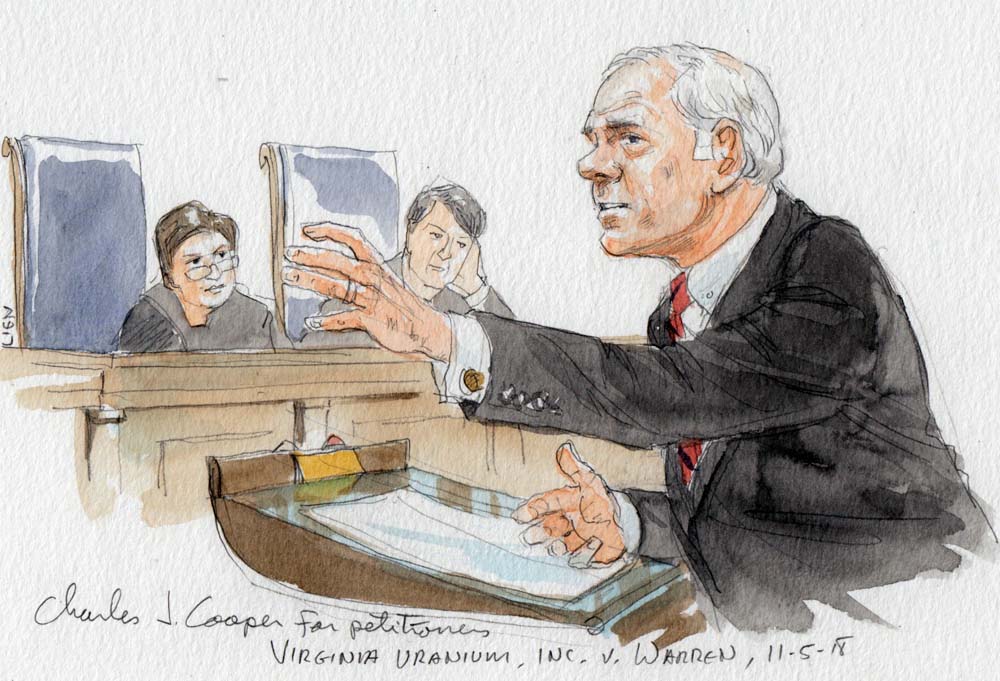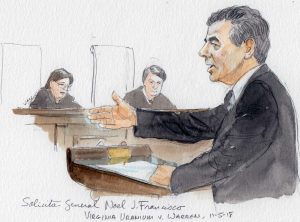Argument analysis: Justices express skepticism over using legislative motive in pre-emption analysis
on Nov 6, 2018 at 11:22 am

The Supreme Court heard oral argument yesterday morning in Virginia Uranium Inc. v. Warren, which concerns the largest uranium deposit in the United States, located in south-central Virginia. The petitioners are owners of the deposit who wish to mine uranium, and they are challenging a 1983 statute by which the Virginia General Assembly imposed a moratorium on uranium mining. Although all parties agree that uranium mining is a matter for state regulation, the owners contend that the moratorium was impermissibly intended to regulate radiation safety associated with uranium milling and tailings management — a field pre-empted by the Atomic Energy Act. The case therefore raises questions about the extent to which a state legislature’s motives are relevant to deciding whether the state statute is pre-empted.
Arguing for the owners, attorney Charles Cooper quickly faced inquiries from the justices on this point. Chief Justice John Roberts and Justice Brett Kavanaugh pressed Cooper to explain how the Supreme Court should review a state statute that is motivated by both permissible and impermissible purposes. Justice Sonia Sotomayor also raised methodological concerns, asking, “Is this going to require deposing every single legislative member?” Justice Neil Gorsuch worried about guessing at state legislators’ motives, noting the “methodological, epistemological, and federalism questions” doing so would raise. And Justice Elena Kagan raised the possibility that two similar state statutes could face different pre-emption outcomes simply because of different legislative history.
In responding to these justices’ worries over developing a workable motive-infused standard, Cooper proposed that the Supreme Court apply the test from the civil rights decision Village of Arlington Heights v. Metropolitan Housing Development Corp. As he explained, if the plaintiff could show that a prohibited purpose was a “motivating factor,” the burden would shift to the state to show that it would have passed the statute even in the absence of that factor.
But attorney Noel Francisco, arguing for the United States as amicus curiae on the side of the owners, offered a different approach. As he explained, a plausible non-safety rationale would save the statute unless it was foreclosed by “the text, legislative history, and historical context.” Francisco also proposed a narrow resolution to the case, in which the court would remand the matter for an inquiry into legislative purpose, because the lower court had assumed a prohibited purpose but held that purpose to be irrelevant.
Sotomayor, Kagan and Gorsuch all expressed doubt that Virginia’s ban is problematic, given that it regulates only uranium mining, not the milling and tailings management that can present radiation-safety issues — a point to which Toby Heytens, the solicitor general of Virginia, returned consistently. He contended that there is no field pre-emption because uranium mining is unregulated by the AEA. Justice Stephen Breyer, however, probed further, inquiring whether states could use impermissibly use their general authority to effectively ban a federally regulated activity. For instance, he asked, what about a state law saying that “[n]o one who works in a tailing place can eat”? Heytens responded that the difference is that mining is completely outside of the federal jurisdiction, so this is not a situation in which the state is regulating an activity within the federal domain.
Further exploring possible state motives, Kavanaugh asked about the “real world,” in which mining and milling are not separated. Heytens pointed to legal line-drawing: The statute separates the two activities, and the Nuclear Regulatory Commission has done so as well, in the context of adjudication. Breyer asked what would be wrong with considering legislative purpose; as he put it, every judge, “including Justice Scalia … sometimes will look to a statute’s purpose.” Heytens responded that federalism concerns counsel against evaluating a state legislative purpose, and here, the text of the statute is clear in banning only mining.
In their briefs, the parties have hotly contested what concessions the commonwealth made in the district court. Justice Ruth Bader Ginsburg asked if Virginia had indeed conceded that the purpose of its ban was to address radiation safety concerns. Heytens explained that the procedural posture of the case required taking the facts alleged as true, but he emphasized that Virginia had not conceded anything.
Heytens’ time concluded with ideological back-and-forth between Breyer and Gorsuch. Breyer opined that courts may reasonably consider statutory purpose, whereas Gorsuch worried over the complications that introducing a purpose-based analysis would bring. He suggested that in a case such as this, it would be appropriate simply to ask whether the legislature had a rational basis for enacting the moratorium.
Returning to offer his rebuttal on behalf of the owners, Cooper pointed the Supreme Court to evidence in the record showing that along with Virginia’s mining ban, the state established an administrative group to consider not just mining but also milling and tailings management. He underscored the owners’ argument that the state’s true purpose was to impermissibly regulate those pre-empted activities. Moreover, he rejected a rational-basis approach to the case, arguing that the court must consider the plausibility of the state’s asserted purpose.
The oral argument suggests that the outcome may well turn on each justice’s views about the appropriateness and workability of looking beyond the text of a statute to evaluate legislative motive. A majority of the justices seemed unwilling to open that Pandora’s box.





